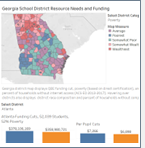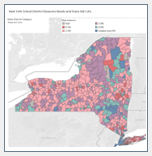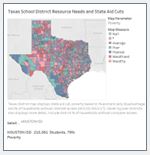As the COVID-19 crisis extends into the 2020-21 school year, the full impact of the pandemic on state funding for K-12 public education continues to unfold. Two key dynamics are in play as states enact FY21 budgets:
- The likelihood of cuts in state school aid and the harsher impact of those cuts on higher poverty districts. Because these aid cuts are recurring, they can cause structural deficits in state support for public education over the longer term.
- The use and distribution of non-recurring federal emergency funds appropriated by Congress to address the impacts of the pandemic on public schools.
Advocates across the country are already mobilizing efforts to maintain adequate state support for public education during and after the pandemic. To assist those advocacy campaigns, ELC’s Resource Equity Research Project will track and analyze state decisions on school aid cuts and the distribution of emergency federal funds, with a focus on the impact on higher poverty school districts.
A critical factor in school funding is the need for more resources in districts serving high proportions of students in poverty. These districts – underfunded by states even before the pandemic – typically depend more on state aid and are less able to offset aid cuts by increasing local property taxes. Now, these districts face an increased need for resources to address the impact of COVID-19 on students, teachers, and schools.
Georgia
In June 2020, amid the economic crisis resulting from the COVID-19 pandemic, the Georgia Legislature enacted a 10% cut in state aid for K-12 public education totaling $950 million. The cut applied equally to all school districts, without regard to student poverty rates. At the same time, Georgia districts received a one-time infusion of federal emergency funds under the CARES Act to address the impacts of COVID-19 totaling $411 million statewide. The CARES Act allocated these funds based on the federal Title 1 formula, so high poverty districts received more funds than wealthier districts.

- Research Brief: Georgia: Equal Education Cuts, Unequal Impacts
- District-Level Views: Georgia’s School District Resource Needs and State Aid Cuts
Michigan
In July 2020, Michigan approved a state aid cut of $175 per pupil in every district, totaling $256 million. The state added $512 from the federal Coronavirus Relief Fund (CRF), at $350 per pupil for every district, along with $351 million through the Elementary and Secondary School Emergency Relief Fund under the CARES Act. The $351 million follows Title I-A funding allocations, sending proportionally more funds to higher-poverty districts in the state.

- Research Brief: Michigan: Equal Aid Cuts Follow Pattern of Ignoring Higher Needs in Poor Districts
- District-Level Views: Michigan’s School District Resource Needs and State Aid Cuts
New York
In April 2020, New York cut $1.1 billion in state aid, an amount equal to the one-time federal funds provided for emergency relief for public schools under the CARES Act. The cuts are disproportionately higher in districts segregated by poverty and those most in need from COVID-19. In August 2020, an additional 20% cut to state aid funding to districts is being considered, with the devastating impact of these additional cuts analyzed in a report by the Alliance for Quality Education in New York.

- Research Brief: New York’s Pandemic Adjustment: Depriving Resources to Students Impacted by COVID-19
- District-Level Views: New York School District Resource Needs and State Aid Cuts
Texas
In June 2020, Texas cut $1.3 billion in state aid, an amount equal to the one-time federal funds provided for emergency relief for public schools under the CARES Act. The cuts are disproportionately higher in districts segregated by poverty and those most in need from COVID-19.

- Research Brief: Texas: Regressive Aid Cut Penalizing Poorest Districts
- District-Level Views: Texas School District Resource Needs and State Aid Cuts